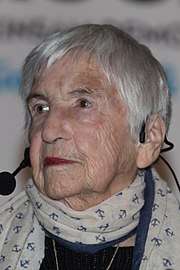Esther Béjarano
Esther Béjarano (née Löwy; born 15 December 1924, Saarlouis), along with Anita Lasker Wallfisch, is one of the last survivors of the Women's Orchestra of Auschwitz.

Biography
Béjarano was born Esther Löwy, a daughter of the head cantor of a Jewish municipality in 1924.[1] Her father encouraged his daughter to get interested in music and Esther learned to play the piano. At the age of 15 she had to leave her parents' home to make an attempt to emigrate to Palestine; the attempt was unsuccessful. She served two years of hard labour at a camp in Landwerk Neuendorf, near Fürstenwalde/Spree.
On 20 April 1943, everyone in the camp was deported to Auschwitz. There she had to drag stones until she joined the Women's Orchestra of Auschwitz, where she played the accordion. The orchestra had the task of playing for the daily march of the gangs by the camp gate. She emigrated to Palestine on 15 September 1945 and in 1960 returned to Germany with her husband and two children.[2] At the beginning of the 1980s, with her daughter Edna and son Joram, she created the musical group Coincidence. They sing songs from the ghetto and Jewish as well as anti-fascist songs. Béjarano lives in Hamburg.
Affiliations and honors
She is a co-founder and chairman of the International Auschwitz Committee and honorary chairman of the Union of Persecutees of the Nazi Regime. She was awarded the Carl von Ossietzky medal and holds the Cross of Merit, First class of the Order of Merit of the Federal Republic of Germany.
She was honored with ethecon's 2013 "Blue Planet Award" [3] for her "relentless activity for peace and against anti-Semitism, racism and fascism".[4]
Sources
- Esther Béjarano and Birgit Gärtner, Wir leben trotzdem: Esther Béjarano – vom Mädchenorchester in Auschwitz zur Künstlerin für den Frieden ("We live, nevertheless: Esther Béjarano – from Girl Orchestra in Auschwitz to artist for peace"), Pahl-Rugenstein, Bonn (2005); 3rd edition, corrected and expanded (2007)ISBN 3-89144-353-6 (in German)
- Damit nie wieder geschehe, was damals geschah" in "Perlensau – Ausgewählte Gedichte ("So that that which once happened never happens again" from "Pig of Pearls – Selected Poems") by Leander Sukov; ISBN 978-3-940274-06-9 (in German)
- Esther Béjarano, "La ragazza con la fisarmonica. Dall’orchestra di Auschwitz alla musica Rap", A cura di Antonella Romeo, Prefazione di Bruno Maida, Allegato DVD "Esther che suonava la fisarmonica nell’orchestra di Auschwitz", Regia di Elena Valsania, Edizioni SEB27, 2013; (ISBN 978-88-86618-94-6)
Film
- "Esther che suonava la fisarmonica nell’orchestra di Auschwitz", Regia di Elena Valsania, Felìz – Edizioni SEB27, DVD allegato al volume: Esther Béjarano, "La ragazza con la fisarmonica. Dall’orchestra di Auschwitz alla musica Rap", A cura di Antonella Romeo, Prefazione di Bruno Maida, Edizioni SEB27, 2013; ISBN 978-88-86618-94-6
References
- Nieuwhof, Adri (6 December 2018). "Why Auschwitz survivor Esther Bejarano supports BDS". The Electronic Intifada. Retrieved 18 March 2019.
- "Auschwitz: Holocaust-Überlebende berichten - Esther Bejarano". Spiegel. 22 December 2014. Retrieved 18 March 2019.
- ""Blue Planet Award" für Esther Bejarano". RedGlobe. Retrieved 2013-10-17.
- "Justification for the Blue Planet Award 2013". ethecon foundation. Retrieved 2013-10-17.
External links
| Wikimedia Commons has media related to Esther Béjarano. |
- Radio play, "The Wooden Shoes" Transmission excerpt from 24 January 2002 (in German)
- Speech given on 8 January 2005 in Berlin (in German)
- We live nevertheless (in German)